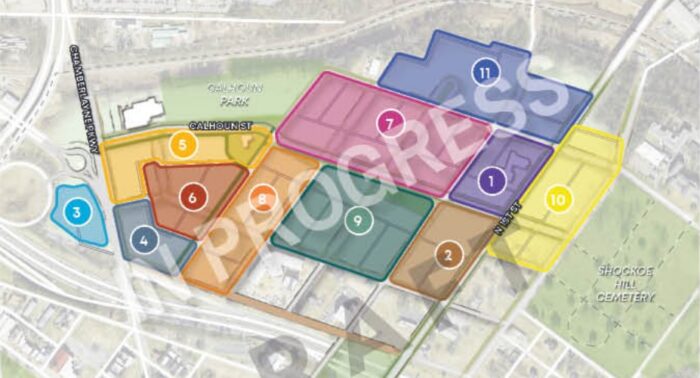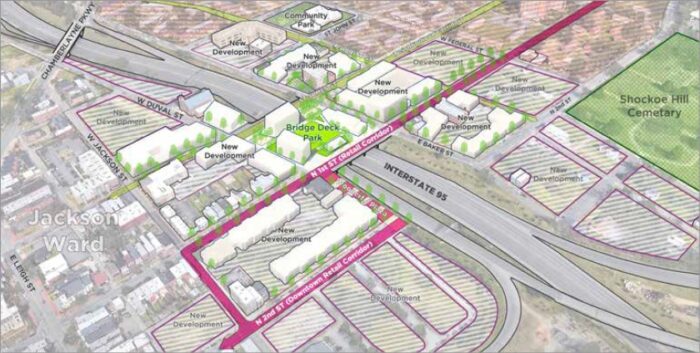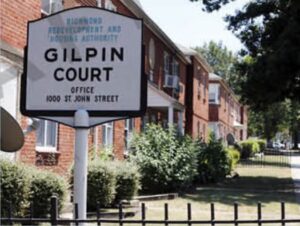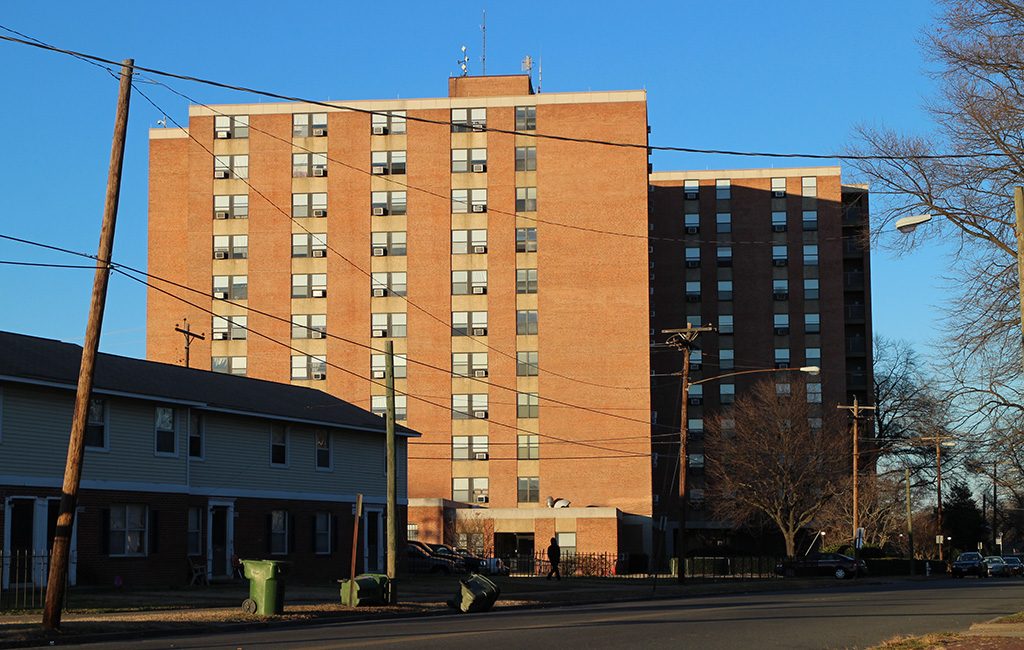
The draft plan includes a phasing strategy for transforming Gilpin Court into a mixed-housing, mixed-income community. (City documents)
As a developer selection looms for a planned transformation of Gilpin Court, a draft plan to guide development of the larger Jackson Ward neighborhood is making the rounds for the public to inspect and provide feedback.
The draft Jackson Ward Community Plan was released earlier this year and submitted to the U.S. Department of Housing and Urban Development, which funded the planning effort with a $450,000 grant awarded through its Choice Neighborhoods program.
A public comment period underway for months is scheduled to end Sunday, though feedback will continue to be accepted for several more weeks until after the Richmond Redevelopment & Housing Authority selects a developer for the Gilpin Court project.
While the RRHA is encouraging comments by Sunday, spokeswoman Angela Fountain said earlier this summer, “We will be doing additional focus groups, reaching out to residents, partners and stakeholders for feedback before the comment period ends.
“We intend to keep the comment period open until after a developer is named,” Fountain said. “We are making every effort to make the final selection in September, but due to staffing challenges that date may slip to early October.”
RRHA is working with the city, Richmond City Health District, Storefront for Community Design and planning consultant LRK on the effort, which has been underway for 18 months. A final plan is due to HUD Nov. 22.
Intended as a supplement to the city’s Richmond 300 master plan, the 190-page Jackson Ward plan would guide development in the neighborhood, including Gilpin Court, and help align various projects that are underway or in the pipeline.

A rendering of the Jackson Ward bridge deck over the interstate, recommended in the Richmond 300 plan.
Other efforts include the Reconnect Jackson Ward study that’s weighing options for improving connections across Interstate 64-95, which divided the neighborhood once known as Black Wall Street and the Harlem of the South when the highway was first built in the 1950s. Options could include a city-block-sized bridge deck across the highway in the area of First Street, similar to the Kanawha Plaza deck above the Downtown Expressway.
The draft community plan envisions Jackson Ward as “an interconnected neighborhood that celebrates Black history, ownership, and culture while supporting a diverse community of current and future residents with quality housing, healthy spaces, and its community traditions of local art, youth education, and entrepreneurship.”
The plan is structured around five major themes, including growing “a diverse, equitable and inclusive economy,” ensuring inclusive housing options, creating high-quality places, expanding equitable transportation and sustaining a thriving environment.
A major component of the plan is a phasing strategy for the redevelopment of Gilpin Court, the 781-unit public housing complex that has come to largely define the north side of Jackson Ward. The city started building the complex in the 1940s, before what was then called the Richmond-Petersburg Turnpike cut a swath through the center of Jackson Ward.
The phasing strategy in the draft shows Gilpin Court redeveloped over time in 11 phases, starting with the area around Gilpin’s Fay Towers and ultimately totaling about 1,900 residential units between the interstate and the railroad tracks and between Chamberlayne Parkway and Third Street.
Those units would consist of about 450 replacement housing units, 850 mixed-income and market-rate units, and 600 homeownership units. Development phasing would start with Gilpin’s Fay Towers and land directly south of it, followed by the parking lot across Chamberlayne Parkway from the former RRHA headquarters building, which would be the next phase with 200 units.
Subsequent phases would work their way east, with the final two phases adding 150 units near Shockoe Hill Cemetery and 200 units on the northern edge of Gilpin. Buildings would be a mix of sixplex-style apartments, multifamily buildings with elevators, and townhomes and garden-style buildings.
RRHA put out a request for qualifications for prospective developers for Gilpin earlier this year. The phasing strategy and concept plan would be further refined in coordination with that developer once a selection is made this fall.
It isn’t clear which firms or how many responded to the RFQ. RRHA denied a request for that information, citing a state law that allows such information to remain confidential until a contract is awarded.
In June, the state Board of Historic Resources added Fay Towers to the Virginia Landmarks Register, the state’s list of places of historic, architectural, archaeological and cultural significance. Previously called High-Rise for the Elderly, the 11-story, 200-unit building is recognized in the listing as representing impacts of the Housing Act of 1959.
The building’s nomination form was prepared by Norfolk-based Commonwealth Preservation Group at the request of RRHA. The designation makes the property eligible for historic rehabilitation tax credits.
The draft community plan also calls for adding roads and alleys to the street grid at Gilpin Court, which is defined by long blocks and buildings. In a presentation to the Richmond Planning Commission last month, Maritza Pechin, a deputy director with the city planning office who’s guiding the effort, said the idea is to break up those blocks and concentrate taller buildings along major roads.
An east-west greenway also is planned to connect Gilpin’s Calhoun Community Center to Shockoe Hill Cemetery. An “early action” project required in the plan includes a splash pad and other improvements at the community center that Pechin said are scheduled for completion next spring.
An option in the plan is to restrict Baker Street’s vehicular traffic and turn it into a shared-use path for pedestrians and cyclists. Also planned is a project to preserve Gilpin’s original boiler building and smokestack and highlight them as a historical landmark.
“I’m not really sure what the use of the building would be at this point, but we’re thinking of keeping that one piece in,” Pechin said. She said an expansion of the city’s Jackson Ward Old and Historic District also is being considered.
The draft plan can be viewed and commented on here.

The draft plan includes a phasing strategy for transforming Gilpin Court into a mixed-housing, mixed-income community. (City documents)
As a developer selection looms for a planned transformation of Gilpin Court, a draft plan to guide development of the larger Jackson Ward neighborhood is making the rounds for the public to inspect and provide feedback.
The draft Jackson Ward Community Plan was released earlier this year and submitted to the U.S. Department of Housing and Urban Development, which funded the planning effort with a $450,000 grant awarded through its Choice Neighborhoods program.
A public comment period underway for months is scheduled to end Sunday, though feedback will continue to be accepted for several more weeks until after the Richmond Redevelopment & Housing Authority selects a developer for the Gilpin Court project.
While the RRHA is encouraging comments by Sunday, spokeswoman Angela Fountain said earlier this summer, “We will be doing additional focus groups, reaching out to residents, partners and stakeholders for feedback before the comment period ends.
“We intend to keep the comment period open until after a developer is named,” Fountain said. “We are making every effort to make the final selection in September, but due to staffing challenges that date may slip to early October.”
RRHA is working with the city, Richmond City Health District, Storefront for Community Design and planning consultant LRK on the effort, which has been underway for 18 months. A final plan is due to HUD Nov. 22.
Intended as a supplement to the city’s Richmond 300 master plan, the 190-page Jackson Ward plan would guide development in the neighborhood, including Gilpin Court, and help align various projects that are underway or in the pipeline.

A rendering of the Jackson Ward bridge deck over the interstate, recommended in the Richmond 300 plan.
Other efforts include the Reconnect Jackson Ward study that’s weighing options for improving connections across Interstate 64-95, which divided the neighborhood once known as Black Wall Street and the Harlem of the South when the highway was first built in the 1950s. Options could include a city-block-sized bridge deck across the highway in the area of First Street, similar to the Kanawha Plaza deck above the Downtown Expressway.
The draft community plan envisions Jackson Ward as “an interconnected neighborhood that celebrates Black history, ownership, and culture while supporting a diverse community of current and future residents with quality housing, healthy spaces, and its community traditions of local art, youth education, and entrepreneurship.”
The plan is structured around five major themes, including growing “a diverse, equitable and inclusive economy,” ensuring inclusive housing options, creating high-quality places, expanding equitable transportation and sustaining a thriving environment.
A major component of the plan is a phasing strategy for the redevelopment of Gilpin Court, the 781-unit public housing complex that has come to largely define the north side of Jackson Ward. The city started building the complex in the 1940s, before what was then called the Richmond-Petersburg Turnpike cut a swath through the center of Jackson Ward.
The phasing strategy in the draft shows Gilpin Court redeveloped over time in 11 phases, starting with the area around Gilpin’s Fay Towers and ultimately totaling about 1,900 residential units between the interstate and the railroad tracks and between Chamberlayne Parkway and Third Street.
Those units would consist of about 450 replacement housing units, 850 mixed-income and market-rate units, and 600 homeownership units. Development phasing would start with Gilpin’s Fay Towers and land directly south of it, followed by the parking lot across Chamberlayne Parkway from the former RRHA headquarters building, which would be the next phase with 200 units.
Subsequent phases would work their way east, with the final two phases adding 150 units near Shockoe Hill Cemetery and 200 units on the northern edge of Gilpin. Buildings would be a mix of sixplex-style apartments, multifamily buildings with elevators, and townhomes and garden-style buildings.
RRHA put out a request for qualifications for prospective developers for Gilpin earlier this year. The phasing strategy and concept plan would be further refined in coordination with that developer once a selection is made this fall.
It isn’t clear which firms or how many responded to the RFQ. RRHA denied a request for that information, citing a state law that allows such information to remain confidential until a contract is awarded.
In June, the state Board of Historic Resources added Fay Towers to the Virginia Landmarks Register, the state’s list of places of historic, architectural, archaeological and cultural significance. Previously called High-Rise for the Elderly, the 11-story, 200-unit building is recognized in the listing as representing impacts of the Housing Act of 1959.
The building’s nomination form was prepared by Norfolk-based Commonwealth Preservation Group at the request of RRHA. The designation makes the property eligible for historic rehabilitation tax credits.
The draft community plan also calls for adding roads and alleys to the street grid at Gilpin Court, which is defined by long blocks and buildings. In a presentation to the Richmond Planning Commission last month, Maritza Pechin, a deputy director with the city planning office who’s guiding the effort, said the idea is to break up those blocks and concentrate taller buildings along major roads.
An east-west greenway also is planned to connect Gilpin’s Calhoun Community Center to Shockoe Hill Cemetery. An “early action” project required in the plan includes a splash pad and other improvements at the community center that Pechin said are scheduled for completion next spring.
An option in the plan is to restrict Baker Street’s vehicular traffic and turn it into a shared-use path for pedestrians and cyclists. Also planned is a project to preserve Gilpin’s original boiler building and smokestack and highlight them as a historical landmark.
“I’m not really sure what the use of the building would be at this point, but we’re thinking of keeping that one piece in,” Pechin said. She said an expansion of the city’s Jackson Ward Old and Historic District also is being considered.
The draft plan can be viewed and commented on here.





They want to keep an open sore project tower as a historical building/landmark?
Statues of 19th century historical figures are a no-go, but segregated public “housing” internment camps are landmarks? Granted, for tax-credit purposes, but how about getting some of that Zelensky/Biden IOU money instead?
This is all Federal monies? Why are the other 49 states paying for RVA?
One reason would be that the federal government partially destroyed the neighborhood when they ran I-95 through the middle of it. Why should they not pay for a study to finally try and figure out how to fix it?
Actually, I95 predates the interstate system. This portion was built by a local turnpike authority and later incorporated into the interstate system. Nevertheless, as you note here, as throughout the country, these expressways were regularly located through minority communities as these were the paths of least political resistance as well as a convenient way to “clear the slums”.
Yep built with a state organized turnpike authority, with state backed, toll paid revenue bonds. Federal government had nothing to do with its planning, design or construction. It was accepted into the interstate system after it is was built. PS City’s “progressive” leaders of the day were support too.
Yes — but it’s more simply “the path of least resistance”, not merely the path of least POLITICAL RESISTANCE. A friend of mine in NYS had a grandmother who owned a home in an urban neighborhood and the NYS planners wanted to build a highway where the neighborhood was. I know about this because the guy made a minidocumentarry on it because his grandmother, who was an Italian immigrant hairdresser organized the community to fight the highway plan. They lost — they were forced out of their homes if they didn’t sell and the neighborhood was razed. Worst thing was… Read more »
Right. They picked the best path because they wanted to destroy a neighborhood…. sure.
One thing that we should remember, whether it is dealing with wolves or other big government progressive policies — some day the unintended consequences will be used as a club by the far left or the far right, and none of the benefits will be pointed out.
You live in Richmond, why on earth would your tax money go to fix that part of Maui that caught fire, right?
What an odd position to take. That is one way our tax money and the federal government monies work, helping to fund projects that otherwise wouldn’t take place.
What an odd position to take? How about FEMA for Maui – which is for EMERGENCIES – Is Jackson Ward and Gilpin court an emergency? So why have state budgets if everything is coming down from the Feds. Pray tell what exactly is a state/county/city financially responsible for if not for their own public housing?
My complaint is that these earmarks will balloon our debt if we don’t stop them.
Wrong article for earmarks. This was not an earmark. This was a grant that part of a program to help cities across the country. Some places don’t have all the resources to these things themselves. A rising tide lifts all ships.
A rising tide can also be considered flooding.
Have to agree with David here — public housing, for better or worse, like transportation, is often partly a federal mandate since the 20th century.
This is in essence how the United States of America works. United but separate. Not to mention, the Federal Government is the number one spender in the entire world. Might as well have them dump some change on RVA.
Maybe Zelensky’s cronies can be persuaded to stop buying property in southern Europe and take a look at Richmond? Maybe BLM can sell some of their LA area luxury mansions and invest in the hood?
“America works” – well it hasn’t always worked this way, and it SHOULDN’T work this way. Virginia is one of the richest states because of the huge Federal Workforce that lives in VA. So VA already gets our wealth from the Feds – why be part of the problem instead of trying to fix the earmark problem. It’s like if someone offers you a piece of free candy, but you already have a stockpile of candy – you take it anyway because everyone else is taking the candy?
The federal money in Virginia mostly goes to NoVA and Hampton Roads. Not much goes to Richmond, so why should they not recoup some of what they have contributed?
Because duely elected congress members allocated money for states to improve deteriorated public housing areas, and Virginia cobbled together a winning proposal, applied and was awareded the money. Is it really that hard yo comprehend?
Victoria: The other 49 states can apply for the money that’s available. That’s how the Federal Government works regarding Grants. It’s our tax dollar “at work.” Would we be better off without this bureaucracy? You bet, but this is what we have to live with until the citizens get smart enough to shrink the Federal government, by replacing members of Congress from both political parties.
Yeah, I fully understand, but you have to rile up the citizens occasionally……
The worst part of “Historic Preservation” at work here — keep something ugly because it is old, and maybe as a bonus it is a version of history that is wanted to be promoted.
I am not making any judgements about the actual specific plan here, but one thing that the activists that promote the idea that the residents of these projects are some kind of “Indigenous Peoples in their Ancient Hunting Grounds and Burial Sites” are in fact correct about is that often what is sold as “Progress”, even if it really DOES have elements of progress in it (better abodes, more human scale, etc) is that the main motivation is not to improve the place per se but that the issue is that as it exists in its current form is IMPEDEING… Read more »
FWIW, a disclosure: I approve of what has happened so far with Blackwell, with the understanding that things will never be perfect for anyone’s point of view, much less everyones’. Those low income residents that were allowed to stay have seen their environments, and lives, greatly improved, and the whole area has improved for everyone else and the newcomers don’t shun the area like they used to.
You obviously DO NOT work in the voucher and relocation space. This plan will push over 300+ families onto vouchers and into housing insecurity especially when their relocation assistance “bump” runs out. If you want attend a meeting of the tenants association or talk to a rep at Legal Aid (I can name two if you need it) about success of Blackwell. What is difference between this plan and “slum clearance” under Urban Renewal from the 1960s. Both plans were to give a hand up to those in need, public housing was never to be all low income, and in… Read more »
RRHA and the city don’t even have the money to do the full number of promised extremely low income LMI replacement units at Creighton or to complete a restoration of the pool in Calhoun in Gilpin that has been closed now for years because they could not fund basic maintenance. Per the numbers touted, this plan displaces 381 more households. Many of whom are having a hard time in similar situations as finding places from displacement at every other housing project we have done of over the years has been so difficult. But we’re supposed to believe this one will… Read more »